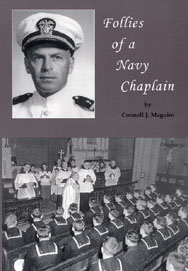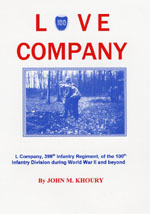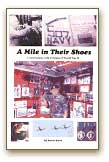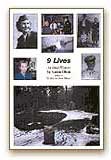©2001, 2008 Glenn E. Schmidt
On the night of January 8, 1945, I was occupying a foxhole adjacent to a narrow road on the east side of Hatten. This road led into a wooded area along the banks of the Rhine River, which separated France and Germany. Because I was armed with a B.A.R. (Browning Automatic Rifle), the position gave a good field of fire for anything approaching up the road, which had been heavily mined the day before. A tank destroyer was dug in on the opposite side of the road.
The weather was very cold with a light snow falling. Earlier in the day the cloud cover was high enough that some flying could be done. It was that day we saw an ME-262 twin jet fighter fly over our positions. I am certain now it was on a reconnaissance mission to determine our positions and strength. It flew so fast, disappearing in seconds, that none of us had an opportunity to fire at it. During the course of the day, we had seen our own artillery spotter aircraft over the area.
Early in the evening my squad was summoned into the nearby bunker for a briefing. A soft glow of candles lit the room and it seemed so comforting from the bitter cold outside. We were handed some mail which had arrived a short time before. The only letter I recall receiving was from my father, who must have sensed we were in a combat zone as he quoted Psalm 91:7 -- "A thousand may fall at your side, and ten thousand at your right hand; but it shall not come near you." Little did we know that within the next few hours and the days beyond we were to prove these words true as I am sure they were sent as a prayer for my protection.
After stuffing the letter in my pocket and watching some of the fellows open delayed Christmas packages, we were told to get a full load of ammunition and hook on two hand grenades. We were to assist the Third Platoon to reestablish a listening post out front of pillbox No. 9. Theirs had apparently been driven back earlier by intense enemy fire with casualties.
Before setting out, I asked the fellows if we could have a moment of prayer. We doffed our helmets and gathered in a circle in the gloom of shadows cast by the few candles in the room. I do not remember what I prayed, but it was a petition for protection in what was to ensue. Every infantryman knows the fear and apprehension of the unknown in a combat situation.
We set off in what I thought was a northwesterly direction and through an orchard someone said was apple. About halfway there, an 88mm shell from the German lines slammed into the earth about 100 yards ahead. I knew they had our positions quite well scouted. I don't know why we were not bracketed by a second round.
After arriving at the Third Platoon position, we were briefed again as to terrain, distance, time of patrol and possible enemy action. We then set out in front of the pillbox, which was a huge concrete structure built in the late 1930s as part of the French Maginot Line. This one was entered from the west side over a small metal bridge through a thick steel door. Facing the east side toward the Rhine, it was built up with a sloping grade of soil to be virtually indistinguishable from a distance. Although of only one main level, it had several rooms and could accommodate a platoon for a length of time. Air vents and a single turret were exposed above it. A large-caliber gun had long since been removed from the turret, which was accessed by a steel ladder embedded in the concrete walls. It was from this turret that my Third Platoon buddy Bill Smith was killed by a direct 88mm hit 24 hours later and my Company Commander, Capt. William A. Corson, was severely wounded. He lost his right eye and received multiple shrapnel wounds to his head, face, right shoulder and arm.
It seemed like it was about 2100 hours we set out single file in front of this pillbox. We passed several foxholes manned by shivering men of the Third Platoon and members of the Weapons Platoon. There were ten of us led by Pfc. Harold L. Finley of St. Clairsville, Ohio. I was the second man. With the rest of the squad behind me was my assistant ammo carrier, a boy from New York. Bringing up the rear was our Platoon Leader, Jim Beers, who on this mission was shot in one heel.
To our left about one mile away was the village of Buhl. The 79th Division artillery was firing on it and had set at least one house on fire by using 105mm white phosphorous shells. This gave enough light that we in our olive drab uniforms could be made out against the falling snow, which was then about 12 inches deep. I was cold and miserable, but the situation was about to get worse. We were spotted by the Germans and they opened up on us. We hit the snow on our bellies and continued to crawl forward, inching our way along. Although a German soldier called out several times, we did not answer or fire for fear of revealing our position. Then I was aware of some enemy on the opposite side of the creek to our left, which may have been but 50 or 75 feet away. A small road on our right crossed the creek over a bridge no more than 100 feet ahead in direct line with the town of Buhl.
In an instant a machine gun opened up directly in front of us, perhaps 150 feet ahead. Three men came up on the bridge carrying a tripod-mounted machine gun. I didn't immediately see them but heard the noise. While lying in the snow, I swung to the left front and opened up with a short burst of about eight rounds. All three fell and as I swung back straight ahead two more men came up on the bridge and were able to get the weapon firing. I was able to knock them both down but their gun must have been set on automatic or one was able to continue firing toward us. The gun seemed to be bouncing around as tracers were going everywhere. They ricocheted off the steel railing of the bridge. (I showed the holes, nicks and scrapes of those bullets to my family in 1962.)
I also realized there were enemy in the creek, possibly as cold or worse off than we. My hands were too cold to wrap around a grenade which I wanted to toss in the creek and under the bridge. At that time one or more machine guns directly in front opened up on us. I could see tracers coming right at me. I could also feel them hitting the snow beside me. I turned my head to see them ricochet up into the air above the pillbox way behind me. I was directly behind Finley, who I determined had been killed in the fusillade.
Within seconds a bullet grazed my chin and another hit my helmet on the left side, knocking it off and losing my wool knit cap. I removed my wool knit gloves also, which were soaked from the snow and the warm barrel of the gun, thinking I could get a better grip on things. It was not to be.
Deciding my future in that position was hopeless, I began crawling backwards after tugging on Finley, who did not move. Then I thought of the helmet which saved my life once -- it just might again! As I reached for it, more bullets came at me. Placing it on my head, it was now too large without the knit cap. I began carrying it while cradling the B.A.R. in my arms. Most of the fellows who were behind me had left the area already, having been recalled by Sgt. Beers. Because we were so strung out and due to the heavy firing, some of us up front did not hear his command to evacuate and return.
As they arrived back at the pillbox, the men told of the heavy barrage going on just a couple of hundred yards in front. With that information, Third Platoon Sgt. Al Cahoon ordered the Weapons Platoon mortars and machine guns to open up in that area. The objective was to blow the bridge and keep the enemy from closing in on us with armor. It was about that time that mortar rounds and what I thought were grenades began exploding around me. White phosphorous lit the area and fragments seemed to engulf me. I felt a hot burning on my back and turned over to scrape snow into the area. It wasn't until I arrived back into the pillbox that I found portions of my field jacket, belt and trousers had small burn holes and flesh burns on my lower back and spinal area.
Some of the events from this moment on are contained in my diary that I kept as a Prisoner of War. Some may be continued in the future. All of the action is documented in two outstanding books: "Winter Storm, War in Northern Alsace, November 1944-March 1945," by Lise Pommois; specifically pages 246-280, and Richard Engler's "Final Crisis." We were assaulted by members of the 21st Panzergrenadier Division.
In August 1962 while serving as a captain in the U.S. Air Force, I was transferred from Castle AFB in California to Phalsbourg Air Base in France. This was just a few miles from Strasbourg and a few more to Hatten. A chaplain friend, Paul Pike, of Olympia, Wash., returned with me to visit a few of the battle areas of World War II. We saw Hatten and the two bunkers. Later, after my family arrived, we returned to Hatten. Showing them around Pillbox No. 9, my two boys ventured inside before I could prevent them. Bruce, my youngest, brought out a grenade which I gingerly placed deep into a gopher hole. Lonnie, my oldest son who was born when I was at Camp Kilmer, N.J., on my way overseas in November 1944, came out with my helmet. It was left there when we were surrendered on the night of January 9. It was unmistakably mine -- the Pfc. stripe is painted off-center and the two bullet holes on the left side are entering from the front, exiting from the rear. I believe now that I was hit when directly behind Finley.
After many years of reflection, I regret to this day being unable to evacuate Finley from that murderous ambush. It is very possible that if I had, you would not be reading this story and the two of us would be lying in that field. All the enemy that night were wearing white capes, pillow cases on their helmets and whitewashed boots. They were virtually invisible a few feet away. We in our olive drab were easy targets at a distance, especially due to the fires in Buhl.
Portions of this story are retold in the fascinating book "Final Crisis," referenced above.
-- Pfc. Glenn E. Schmidt./ 1st Squad, 1st Platoon/ Co. A, 242nd Infantry Regiment/ 42nd "Rainbow" Division
![]() Stories
The POW Diary of Glenn E. Schmidt
Stories
The POW Diary of Glenn E. Schmidt
![]()






